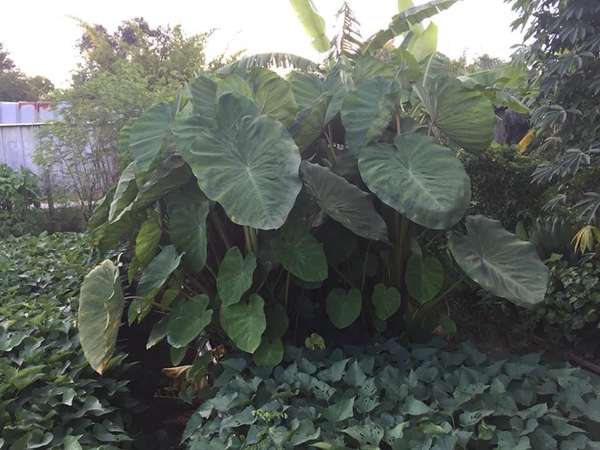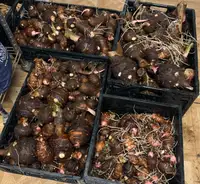Description
Taro is a major aroid that contains a starchy, edible corm high in carbohydrates. Corms are enlarged stem tissue that stores plant reserves underground. Corm size and shape vary based on variety, agronomic practices, and ecological factors. Cormels are corms that form on the sides of the main corm.
Varieties are categorized into upland and lowland groups based on irrigation requirements. Lowland varieties are typically grown in permanently flooded paddies while upland varieties are grown in regular planting beds, in agroforestry systems, and even on hillsides. Varieties are also characterized by corm and cormel formation. C. esculenta var. esculenta, also called dasheen, has larger main corms and smaller cormels while C. esculenta var. antiquorum, also called eddoe, has smaller central corms and larger cormels (Labot, 2009). Corm cores can be white, yellow, orange, pink, red, and even purple. Planting to harvest is anywhere from 5 to 12 months depending on variety. Taro’s geographical origin is from Asia, Southeast Asia, and Melanesia.
Benefits
Taro can fill several agroecological niches not filled by many crops, particularly in water-logged soils which host very few crop species. Taro is well adapted to understory cultivation in agroforestry schemes and is more tolerant of rainforest climate than most cultivated starch crops. Taro has multiple edible parts, including nutritious leaves and starchy corms. It is not susceptible to the diseases and pests that affect sweet potato (Ipomea batatas) and can fit into rotation schemes. Taro has a longer shelf life than sweet potato (in the presence of weevils) as well as cassava (Manihot esculenta), which can make it a valuable crop for storage purposes. It has a shorter shelf life than Dioscorea yams. Cultivation can be very simple/primitive. There is speculation that taro is one of the oldest crops under human domestication, where people were semi-farming with very crude tools like digging sticks.
Cultivation

Figure 7. Mature taro plants (upland variety). Source: Josh Jamison
Replant taro annually. Plant whole corms 15 to 45 cm below the soil surface, making sure that the top of the corm is upward in the planting hole. The depth of planting depends on your soil type and health as well as the taro variety. Plant varieties that produce large central corms a little deeper than those that produce cormels. Corms form up the plant shoot system as the plant grows. If propagation pieces are planted too shallow, corms will be smaller at harvest and plants will have more leafy material. Use pieces from the previous season that are a bit larger than the size of an egg (200-400 g). Using pieces smaller than this will lead to weak plants. In drought-prone areas, use larger pieces to ensure success. Plant in triangulated rows, 50-80 cm between rows and 60-100 cm between plants. Larger-leafed varieties (Figure 7) need wider spacing than more narrow-leafed varieties.
Temperatures under 15°C lead to dormancy for most cultivars (Labot, 2009). If your area gets frost, make sure to plant after the last possible chance of frost to prevent shoot damage. Freezing temperatures will kill plants.
In most contexts, taro is not fertilized. Plants respond well to amendments between 3 to 4 months after planting when rapid root growth is occurring (Labot, 2009). Potassium is essential for cormel initiation but can cause an overproduction of cormels in soils high in potassium. Researchers Hartemink and Johnston (1998) found that fertilization3 increased yields when harvesting taro mid-season at 126 days (~4 months) after planting but did not significantly increase yield when harvested at 231 days (~7.5 months) after planting.
Watering requirements vary by variety. Water supply is most important during the first 20 weeks after planting, when most of the shoot system develops. Upland varieties are more drought-resistant with some varieties not able to handle flooding. Lowland varieties are either cultivated where water is constantly moving or in paddies that are permanently flooded.
Some farmers in Nigeria cultivate taro and rice together with two rows of taro at 60 x 60 cm spacing alternating with four rows of rice (Labot, 2009). Possible upland taro intercrops include beans, sweet potatoes, sweet corn, and groundnut (Peña and Melchor, 1993).
Weed management is important in the first four months of growth or until the canopy closes and taro naturally shades out weeds.

Figure 8. Harvested taro corms. Source: Josh Jamison
Harvest (Figure 8)
If your area receives frosts, harvest before the first frost. Taro is mature when older leaves begin naturally to die back and individual leaf stems become shorter. You may also notice corms above the soil surface starting to form a bottleneck shape. If soil fertility and irrigation requirements are met, you can expect upland taro corm yields of between 30 and 60 t/ha though yields of up to 110 t/ha have been recorded (Spriggs, 1981). Without intensive management, expect yields of 8 to 16.5 t/ha (Lebot, 2009).
Pests and diseases
There typically aren’t many pests that affect taro. Taro beetles (Papuana spp. and Eucopidocaulus spp.), taro leafhoppers (Tarophagus proserpina), aphids (Aphididae), taro hawkmoth (Hippotion celerio), and apple snails (Ampullariidae) are a few pests that have economic importance for taro (Lebot, 2009). Control methods for taro beetles include wood ash, flooding, trap cropping (e.g. with wild sugarcane [Saccharum spontaneum] or bananas [Musacaeae]), mulching, intercropping, adjusting planting time, and biological control. Taro leafhoppers and aphids vector viruses that impact crop growth and also cause leaf damage by sap-sucking. Taro root aphid (Patchiella reaumuri) is only an upland taro pest while apple snails are typically only pests on lowland taro crops. Nematodes can also impact taro yields in both lowland and upland contexts. Bacterial soft rot and taro leaf blight are the major microbial diseases of taro. Some of the best ways to mitigate both insect and microbial diseases for taro are to use crop rotations, using uninfected planting material, and growing in polycultures (intercropping).
Nutrition and cooking
Corms of several aroids are edible but must be processed before consumption due to high levels of oxalic acid. The crystals of calcium oxalate feel uncomfortable when ingested, similar to the poke of a needle, and can cause severe stomach aches. Varieties contain different concentrations of oxalates. One variety, “Lampung hitam” which is cultivated in Bogor, Indonesia, has levels that are so low that corms only need to be cooked a short time (Lebot, 2009). Among 20 varieties, crude protein and total oxalate content of corms were 1 to 2% and 8 to 130 mg/100 g respectively (Sen et al., 2005).
Taro is traditionally processed into a paste called “poi” in Hawaii or “achu” in Ghana. Corms or cormels are boiled, peeled, then pounded in a mortar and pestle until smooth. Sometimes, the paste is fermented. Another traditional processing method from Nigeria is to boil (for about three hours) then peel and cut into 1 cm slices that are dried in the sun until they break apart between your fingers (Nwana and Onochi, 1979). Taro flour and chips can also be made by air-drying and then grinding or frying, but you must select varieties with low levels of oxalates for these purposes.
Taro leaves of some varieties are edible. Leaves are 4.2% protein and contain 426 mg total oxalate/100 g of leaf material, with most of the oxalates in the form of calcium oxalate (Bradbury and Holloway, 1988).
References
Bradbury, J.H. and W.D. Holloway. 1988. Chemistry of Tropical Root Crops: Significance for Nutrition and Agriculture in the Pacific. ACIAR Monograph No. 6.
Hartemink, A.E. and M. Johnston. 1998. Root biomass and nutrient uptake of taro in the lowlands of Papua New Guinea. Tropical Agriculture (Trinidad) 75(1): 1-5.
Lebot, V. 2009. Tropical Root and Tuber Crops: Cassava, Sweet Potato, Yams and Aroids. CABI.
Nwana, I.E. and B.E Onochie. 1979. The technical and social problems of taro processing and storage in Nigeria. In: Plucknett, D.L. (ed.) Small-Scale Processing and Storage of Tropical Root Crops. no. 1:100-109.
Peña, R.S. and F.M. Melchor. 1993. Effects of mulching and intercropping on upland taro. In: Ferentinos, L. (ed.) Proceedings of the Sustainable Taro Culture for the Pacific Conference. HITAHR, University of Hawaii Research Extension Series 140:46-47.
Sen, S., A. Bhattacharya, D. Maxumdar, H. Sen, A.K. Das, and S. Pal. 2005. Nutrient and antinutrient composition of cormels of Colocasia esculenta var. antiquorum. Journal of Vegetable Science 11(4): 17-33.
Spriggs, M. 1981. Vegetable kingdoms: taro irrigation and pacific prehistory. PhD. Thesis, Australian National University, Canberra.